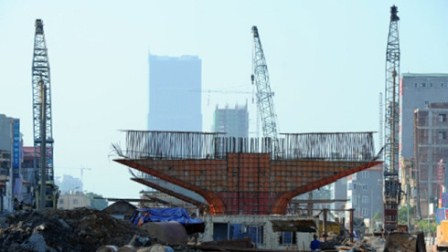In real terms, the Vietnamese construction industry registered a growth rate of 9.1% in 2016, measured at constant 2010 US dollar exchange rates, according to latest report by ReportLinker, an award-winning market research solution.

This was preceded by annual growth rates of 10.8 per cent, 7.6 per cent, 5.9 per cent and 6.4 per cent in 2015, 2014, 2013 and 2012 respectively.
According to the report, this growth was supported by economic recovery, coupled with government investment in infrastructure and residential construction, and the increased issuance of building permits. In addition, the Socio-Economic Development Plan (SEDP) for 2011–2015, under which the government invested in the development of industrial facilities, supported review-period (2012–2016) growth.
The country’s construction industry is expected to expand in real terms over the forecast period (2017–2021), due to investments in transport infrastructure, energy and utilities and affordable housing projects.
Additionally, government investment in public infrastructure and educational healthcare buildings as part of the 2016–2020 Development Plan will support this growth.
The government is planning to increase the country’s seaport capacity under the new master plan for seaport system development for 2020. Additionally, the government launched the 2020 Broadband Plan in January 2016, to support economic development and growth. Through this, the government aims to create investment opportunities, and ensure social and economic inclusion.
In real terms, the industry’s output value is anticipated to post a forecast-period compound annual growth rate (CAGR) of 7.78 per cent, compared to the CAGR of 8.33 per cent recorded during the review period.
Key Highlights
The construction industry is expected to benefit from the government's plans to improve living conditions in rural areas. In August 2016, the government launched a new rural building program for 2016–2020, with an aim to build schools, hospitals, roads, water-treatment facilities and other related infrastructure in rural areas by 2020.
Under Vietnam’s Railway Development Strategy 2020, the government aims to increase the share of passenger and freight transport by railway from 0.5 per cent of the total passenger transport market share and 1.0 per cent of the total freight transport in 2015 to 13.0 per cent in terms of passenger transport and 14.0 per cent in terms of freight transport by 2020.
Accordingly, the Ministry of Transport (MOT) proposed a plan to develop the North-South railway infrastructure. It includes the construction of a dual-track broad-gauge line connecting Hanoi and Ho Chi Minh City, two express railway sections, and upgrades to the existing railway.
The government’s focus on developing seaports with an aim to increase trade volume in the country is expected to drive growth in the infrastructure construction market over the forecast period. In 2015, the government announced Vietnam's new Master Plan for Seaport System Development 2020, to develop the country's port infrastructure.
The government aims to increase Vietnam's housing area per capita from 16.7m2 per person in 2015 to 25.0m2 per person by 2020. Consequently, the government is planning to build 1.0 million affordable houses by 2020. Accordingly, it launched various social housing programs such as the Housing for Poor Rural Families Program, low-rent housing for industrial zone employees and low-income urban social housing-local government.
The government is focusing on the manufacturing sector with an aim to attain middle-income status and become a fully industrialized country by 2020.
Source: VOV